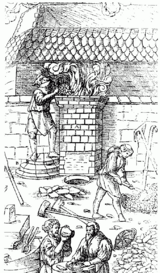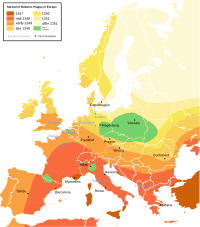Economics of English Mining in the Middle Ages facts for kids
The Economics of English Mining in the Middle Ages is about how mining worked in England from the Norman invasion in 1066 until 1509. Even though farming was the main way people made a living, mining for iron, tin, lead, silver, and later coal was very important for England's economy during this time.
Contents
Early Norman Period (1066–1100)
After William the Conqueror took over England in 1066, he set up a new system of government. This system, called feudalism, meant that land ownership was linked to serving the king. However, William's rule didn't change much about how the English economy or mining worked right away.
Mining Grows in the Middle Ages (1100–1290)
Mining wasn't the biggest part of England's economy back then. But in the 1100s and 1200s, people needed more metals. This was because the population was growing, and many big buildings like cathedrals were being built. Four main metals were mined in England: iron, tin, lead, and silver. Coal mining also started in the 1200s.
Iron Mining in Medieval England
Iron was mined in several places. The main area was the Forest of Dean. Other places included Durham and the Weald. By the late 1200s, some iron was also brought in from other countries.
At first, people got iron ore by digging it from the surface. But by the late 1100s, they started using more advanced ways. This included digging tunnels, trenches, and bell-pits. Iron ore was usually processed nearby in a bloomery. By the 1300s, the first water-powered iron forge was built in England at Chingley.

Silver and Tin Mining
A lot of silver was found near Carlisle in 1133. This led to a "silver boom" in England. Mines across Cumberland, Durham, and Northumberland produced huge amounts of silver. They mined up to three or four tonnes each year. This was more than ten times what all of Europe produced before! This silver boom helped the local economy and the king's money a lot.
Tin mining was mainly in Cornwall and Devon. Miners found tin in river deposits. Special courts called Stannary Courts and Parliaments managed tin mining. Tin was a valuable export good. It was first sent to Germany, and later to the Low Countries.
Lead Mining
Lead was often found when people were mining for silver. There were lead mines in Yorkshire, Durham, the north, and Devon. These lead mines often struggled financially. They usually survived because the silver production helped pay for them.
Coal Mining Begins
As forests became smaller, wood and charcoal became more expensive. This led to a higher demand for coal in the 1100s. Coal started to be mined commercially from bell-pits and surface digs.
Tough Times: Famine and Black Death (1290–1350)
England faced big problems in the early 1300s.
The Great Famine
The Great Famine started in 1315. There were bad harvests in 1315, 1316, and 1321. Animal sicknesses also affected sheep and oxen. Many people died because there wasn't enough food. This famine stopped the population growth that had been happening for centuries. It shook the economy, but didn't completely destroy it.
The Black Death Arrives

The Black Death was a terrible sickness that came to England in 1348. It returned in waves over the next few decades. Many people died, from about 27% of the rich to 40-70% of farmers. Even though so many people died, most towns weren't completely abandoned. However, many were badly affected.
Building work stopped, and many mining operations paused. The government tried to control wages and keep working conditions the same as before. But the long-term effects were huge. The English population didn't start to recover for over a hundred years. This crisis affected English mining for the rest of the Middle Ages.
Economic Recovery (1350–1509)
Mining generally did well towards the end of the Middle Ages. People wanted more manufactured and luxury goods.
Tin and Lead Production
Cornish tin production dropped sharply during the Black Death. This caused prices to double. Tin exports also fell, but they recovered quickly in the following years. By the early 1500s, it became harder to find tin in river deposits in Cornwall and Devon. So, miners started using bell and surface mining more. This helped the tin boom that happened in the late 1400s. Lead mining also increased, almost doubling its output between 1300 and 1500.
Coal and Iron Production
After the Black Death, wood and charcoal became cheaper again. As a result, coal production went down and stayed low for the rest of the period. Still, by the 1500s, some coal was being mined in all the main English coalfields.
Iron production kept increasing. The Weald in the South-East started using water-power more. In the 1400s, it became England's main iron-producing area, taking over from the Forest of Dean. A big step forward in metal processing happened in 1496. The first blast furnace in England was built in Newbridge in the Weald.

